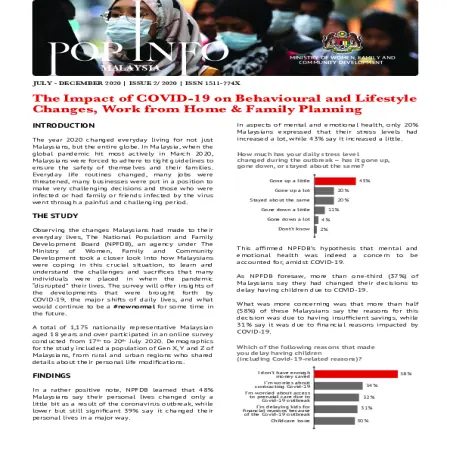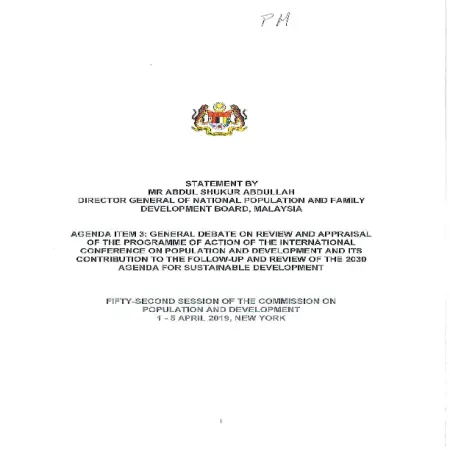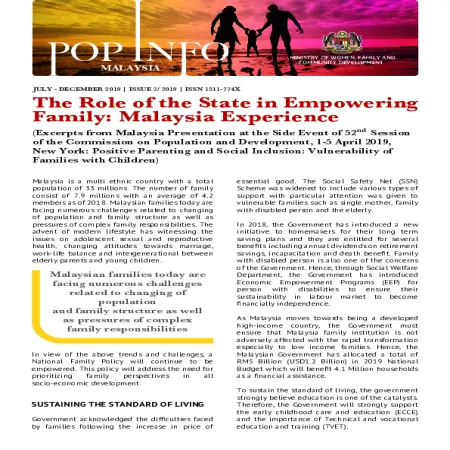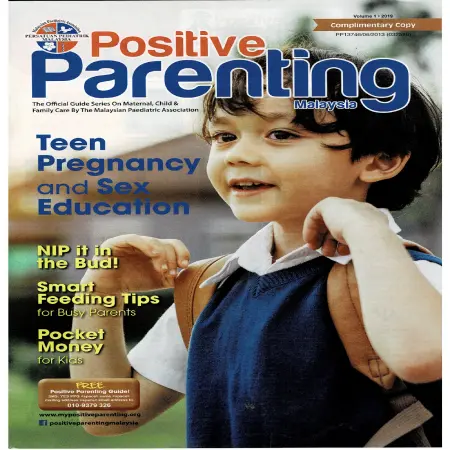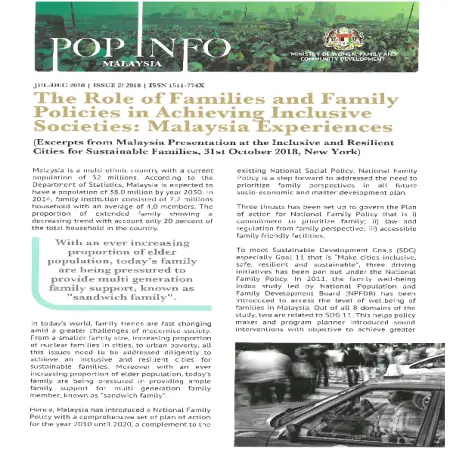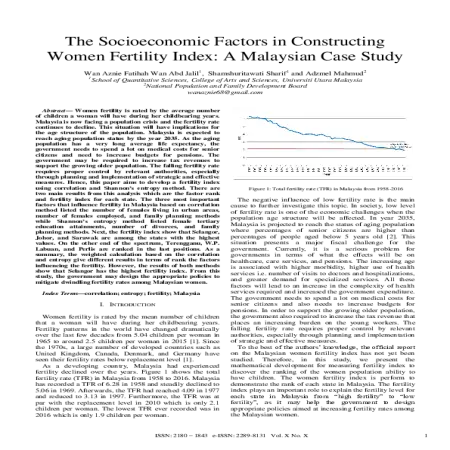Browse by Year
|
|
The Family Well-Being Index 2019
Item Type: Video
Editor:
Year: 00/00/2020
Abstract: A Short video on Family well-being index. The family well-being index (FWBI) is developed to measure the level of family well-being in the country. To continue monitoring the level of well-being of Malaysian families, the third series of FWBI was held in 2019 maintained all eight domains of FWBI 2016.
|
|
|
|
|
|
The impact of COVID-19 on behavioural and lifestyle changes, work from home & family planning
Item Type: Newsletter
Editor:
Year: 00/00/2020
Abstract: This survey will offer insights of the developments that were brought forth by COVID-19, the major shifts of daily lives, and what would continue to be a #newnormal for some time in the future.
|
|
|
|
|
|
The 52nd session of the commission on population and development:general debate on review and appraisal of the programme of action of the international conference on population and development and its contribution to the follow-up and review of the 2030 agenda for sustainable development
Item Type: Country Statement
Editor:
Year: 01/04/2019
Abstract: The population of Malaysia has increased more than three-fold from 10.5 million in 1970 to about 33 million today. the population was growing around 2.5 percent per annum for the period 1970-2000 but it has declined to 1.7 percent between 2010 and 2018.
|
|
|
|
|
|
The role of the state in empowering family: Malaysia experience
Item Type: Newsletter
Editor:
Year: 00/00/2019
Abstract: Malaysia families today are facing numerous challenges related to changing of population and family structure as well as pressure of complex family responsibilities. The advent of modern lifestyle has witnessing the issues on adolescent sexual and reproductive health, changing attitudes towards marriage, work-life balance and intergenerational between elderly parents and young children. In view of the above trends and challenges, a National Family Policy will continue to be empowered.
|
|
|
|
|
|
Teen pregnancy and sex education
Item Type: Article
Editor:
Year: 00/00/2019
Abstract: Teenage pregnancy refers to any pregnancy in women or girls aged 19 years or younger. In 2016, the Ministry of Health recorded more than 12,000 teenage pregnancies in Malaysia. The National Registration Department reported that 4,992 children were born out of wedlock to girls aged 18 years and below. Teenage pregnancy is associated with immediate as well as long-term health risks. It is also accompanied by a number of negative consequences that are detrimental to the well-being of young mothers – disruption of education, limitation of opportunities for self-development and employment, social stigma and increased exposure to violence and exploitation. This article examines some circumstances resulting in teenage pregnancy and explores ways to support teenagers who face difficulties resulting from unintended pregnancy.
|
|
|
|
|
|
The 51st session of the commission on population and development :general debate on sustainable cities, human mobility and international migration, New York
Item Type: Country Statement
Editor:
Year: 09/04/2018
Abstract: Malaysia has taken the initiatives to systematically coordinate sustainable urban planning and development, with emphasis on a balanced development; physically, environmentally, socially and economically, such as through the introduction of the Safe City Concept, and Go Green Kuala Lumpur Car-Free Morning.
|
|
|
|
|
|
The role of families and family policies in achieving inclusive societies: Malaysia experiences
Item Type: Newsletter
Editor:
Year: 00/00/2018
Abstract: With an ever increasing proportion of elder population, today’s family are being pressured to provide multi generation family support, known as “sandwich family”. Hence, Malaysia has introduced a National Family Policy with a comprehensive set of plan of action for the year 2010 until 2020, a complement to the family well-being index. Next, community based intervention program called Family and Community Empowerment Program (FACE) and Family Impact Assessment (FIA) where an evaluation on the impact of family-related policies and program will be accessed.
|
|
|
|
|
|
The socioeconomic factors in constructing women fertility index: a Malaysian case study
Item Type: Article
Editor:
Year: 01/06/2017
Abstract: Women fertility is rated by the average number of children a woman will have during her childbearing years. Malaysia is now facing a population crisis and the fertility rate continues to decline. This situation will have implications for the age structure of the population. Malaysia is expected to reach aging population status by the year 2035. As the aging population has a very long average life expectancy, the government needs to spend a lot on medical costs for senior citizens and need to increase budgets for pensions. The government may be required to increase tax revenues to support the growing older population. The falling fertility rate requires proper control by relevant authorities, especially through planning and implementation of strategic and effective measures. Hence, this paper aims to develop a fertility index using correlation and Shannon's entropy method. There are two main results from this analysis which are the factor rank and fertility index for each state. The three most important factors that influence fertility in Malaysia based on correlation method listed the number of females living in urban areas, number of females employed, and family planning methods while Shannon's entropy method listed female tertiary education attainments, number of divorces, and family planning methods. Next, the fertility index show that Selangor, Johor, and Sarawak are among the states with the highest values. On the other end of the spectrum, Terengganu, W.P. Labuan, and Perlis are ranked in the last positions. As a summary, the weighted calculation based on the correlation and entropy give different results in terms of rank the factors influencing the fertility. However, the results of both methods show that Selangor has the highest fertility index. From this study, the government may design the appropriate policies to mitigate dwindling fertility rates among Malaysian women.
|
|
|
|
|
|
The 50th session of the Commission on Population and Development: general debate on changing population age structures and sustainable development
Item Type: Country Statement
Editor:
Year: 00/00/2017
Abstract: This Country Statement address about four important sub-topics namely changing population age structures, fertility trends and initiatives, adolescents and youth as well as trends in working age population.
|
|
|
|
|
|
Terapi minda: rangsang minda anak
Item Type: Article
Editor:
Year: 00/10/2016
Abstract: Mind therapy is one of the methods that can be used to plan and shape the child's mental intelligence. In general, mind therapy is the treatment of the mind in a rehabilitative manner without the use of medication or surgery. According to studies, the human mind is divided into two parts. The first part is located on the left side which is called the conscious mind while the right side is called the subconscious mind. The conscious mind functions to think of logical things such as reading, counting or in other words this mind functions throughout the time we are conscious. The subconscious mind's function is to receive whatever is heard, smelled and felt. It works non -stop whether we are asleep or awake.
|
|
|
|






